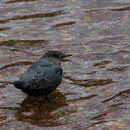en
names in breadcrumbs


Perception Channels: visual ; tactile ; acoustic ; chemical
IUCN Red List of Threatened Species: least concern
None
None
The American Dipper feeds on freshwater invertebrates, especially insect larvae, and very small fish. They have also been known to feed on small aquatic plants.
Cinclus mexicanus, the American Dipper, can be found in the mountains of western North America from lower California to northern Alaska. It is also found in Mexico south to Panama. The American Dipper never leaves the company of water. During winter, they sometimes become more common in the lower reaches of the streams on the western slopes of the Sierra Nevada (California). In California, Dippers range in elevation from sea level along the central and northern coast, to over 9,000 feet in the central Sierra Nevada, and upwards to 10,000 feet in the White Mountains. Wanderers occasionally exceed 12,000 feet in the central Sierra Nevada. (Schoenherr 1995, Small 1994)
Biogeographic Regions: nearctic (Native ); neotropical (Native )
American Dippers prefer swift, clear, cold, permanent streams, especially those with large boulders, tumbling waterfalls, steep cliffs and ledges which can be used as sheltered nest sites. These sites are often located under the waterfalls. Man-made culverts, bridges, and small dams may also be utilized as nest sites. Where such streams flow into clear lakes and ponds, Dippers are often found foraging along the edges of the latter as well. Primary life zones for breeding are Canadian (and occasionally in the upper Sonoran), often extending upwards into the Hudsonian or even higher. The elevation range is from sea level along the central and northern coast, to over 9,000 feet in the central Sierra Nevada, and upwards to 10,000 feet in the White Mountains of California. Wanderers occasionally exceed 12,000 feet in the central Sierra Nevada of California.
(Small 1994)
Terrestrial Biomes: mountains
Average lifespan
Status: wild: 86 months.
Adult American Dippers grow to roughly 18 cm (7 in.) in length from beak to tail. In the spring, adults are slaty or deep neutral grey on their body, brown on their head and neck, and a darker gray to almost black on their wings and tail. The upper eyelids are touched with a narrow border of white feathers, and their bill is black. Their feet are yellow in color.
During the fall and winter, the colors of adults and immature males and females change. The feathers of underparts become margined with white, and they also have white edging on the wings. The bill turns to a light brown. Young American Dippers are a much lighter color on their stomach compared to the adults. The throat is nearly white, the wing feathers and occasionally tail feathers extensivily are white. Their bill is yellow.
This dipper has large oil glands to help waterproof feathers, and nasal flaps that allow it to close the nostrils under water (Welty 1982)
Other Physical Features: endothermic ; bilateral symmetry
Average mass: 50.2 g.
The mating ritual consists of the male stretching his neck upward, bill vertical, wings down, partially spread. The male then struts and sings before the female. If the song is right, the male and female will perform together ending the song with their breasts touching.
The American Dipper produces about four to five eggs that are 26 mm x 19 mm in size. The incubation period lasts about 16 days. After birth, the young dipper will remain about 24-25 days under the parents care.
Key Reproductive Features: iteroparous ; gonochoric/gonochoristic/dioecious (sexes separate); sexual ; oviparous